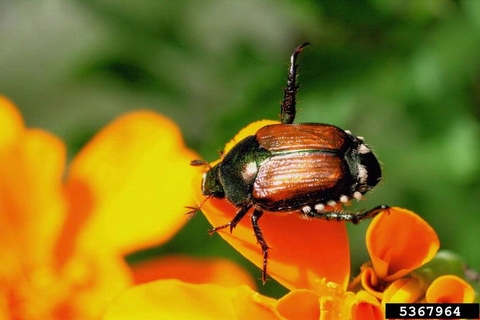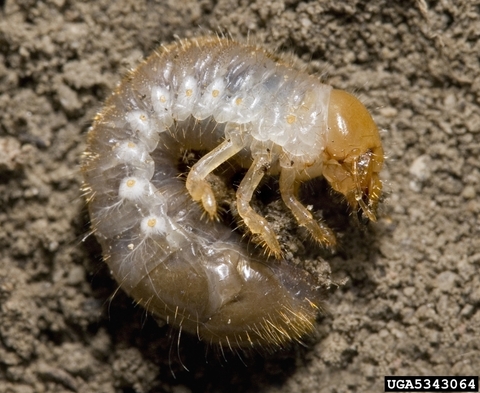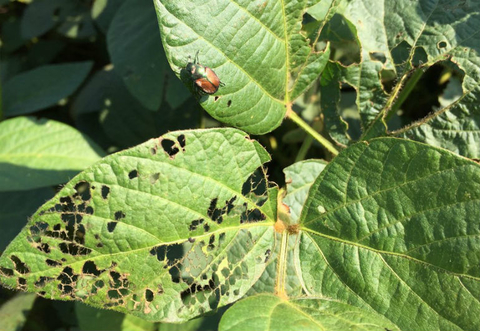Identification of Japanese beetle (Popillia japonica)
Adult (Figure 1a)
- Approximately one-third to one-half inch long.
- Metallic green head with copper-brown wing covers (elytra).
- Sides of abdomen have five white patches of hairs, and tip of abdomen has two patches of white hair.
Egg
Eggs are laid in the soil and generally not seen.
Larva (grub) (Figure 1 b)
- C-shaped, white to cream-colored grubs.
- Up to about one inch long.
Natural history
Japanese beetles were originally from Asia and were first detected in the U.S. in the early 1900's and now occur throughout much of the eastern United States. In Minnesota, Japanese beetles are established in the Twin Cities and other urban areas in the southeastern region of the state. Recently, their populations have begun to expand into surrounding agricultural areas.
Japanese beetles overwinter as grubs in soil in grassy areas. In spring, grubs move toward the soil surface, pupate, and emerge as adults in mid to late June. Japanese beetles feed on over 300 different plant species, including soybean. Adults aggregate and feed on foliage and occasionally flower structures of many plants.
Adults mate and females lay eggs in nearby grassy areas (particularly turf), but will occasionally lay eggs in soybean fields. Eggs hatch after about one to two weeks, and the grubs feed primarily on the roots of grasses, but will occasionally feed on roots of other plants, such as soybean.
As soils cool in the fall, grubs dig deeper in the soil, where they overwinter. Japanese beetles have one generation per year in Minnesota.
Impacts
Adults feed between leaf veins of soybean leaves, resulting in a lace-like appearance (i.e. skeletonizing) (Figure 2). Heavy infestations can cause significant levels of defoliation, which can lead to reduced soybean yield. Grubs may feed on soybean roots, but rarely cause economic damage.
Scouting and management
Management decisions for Japanese beetle are based on estimates of defoliation. Because this pest and its defoliation are often highly aggregated in fields, sampling should be performed throughout fields and take into consideration the entire canopy (top, middle, and bottom leaves).
Scouting
Estimate defoliation from at least 10 plants from throughout the field. To estimate percent defoliation:
- From each plant, select a leaf from the top, middle, and bottom third of the plant.
- Use Figure 3 to estimate percent defoliation for each leaf and then determine the average percent defoliation across the three leaves from each plant and then across multiple plants.
- The average percent defoliation for the field's canopy can be compared to treatment thresholds discussed below.
Treatment thresholds
From vegetative plants (before flowering), treat if adults are present and defoliation reaches 30 percent.
For reproductive plants (flowering to pod fill stage), treat if adults are present and defoliation reaches 20 percent.
Labeled rates of insecticides can be used to manage this pest. Follow directions on the product label.
Reviewed in 2016





